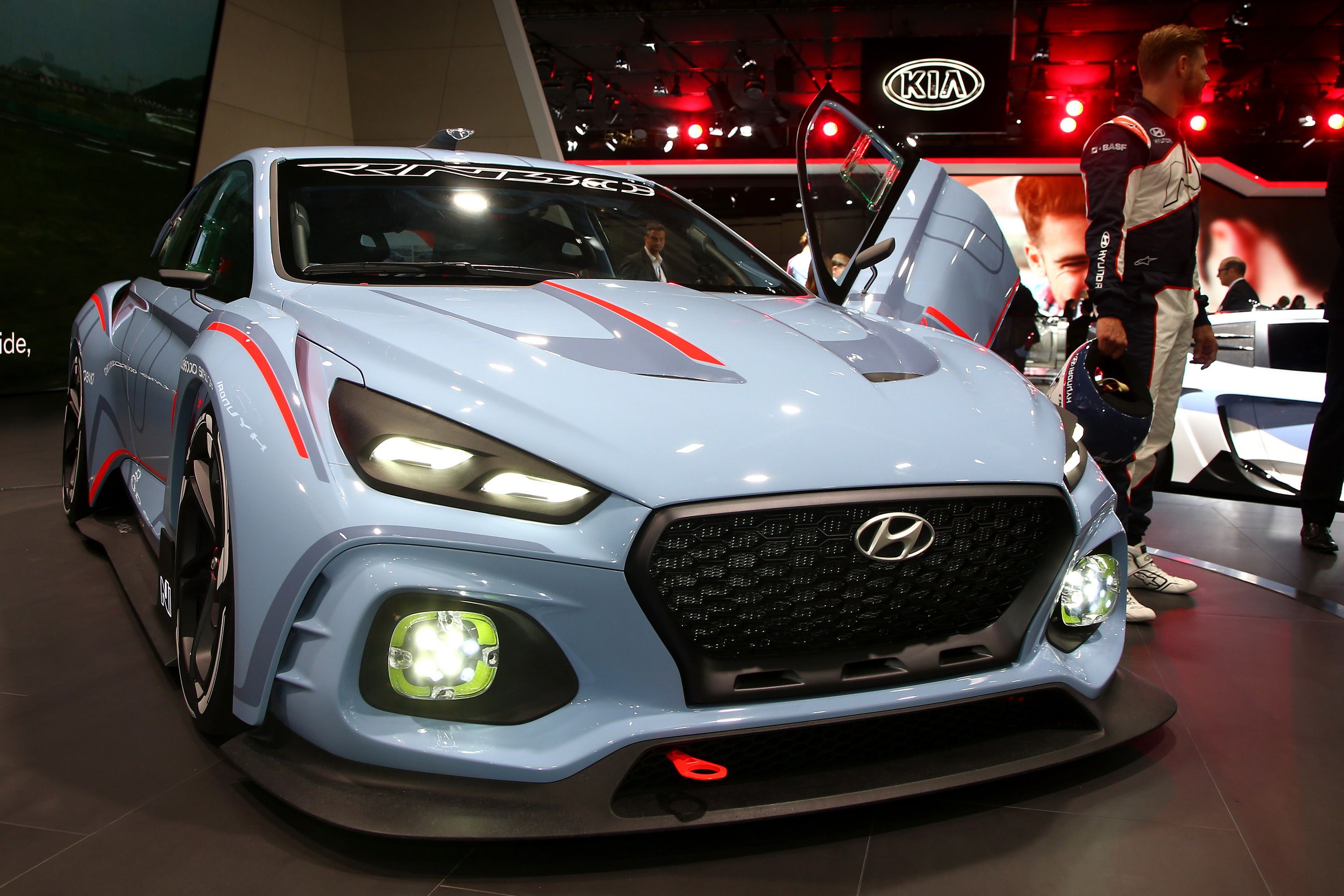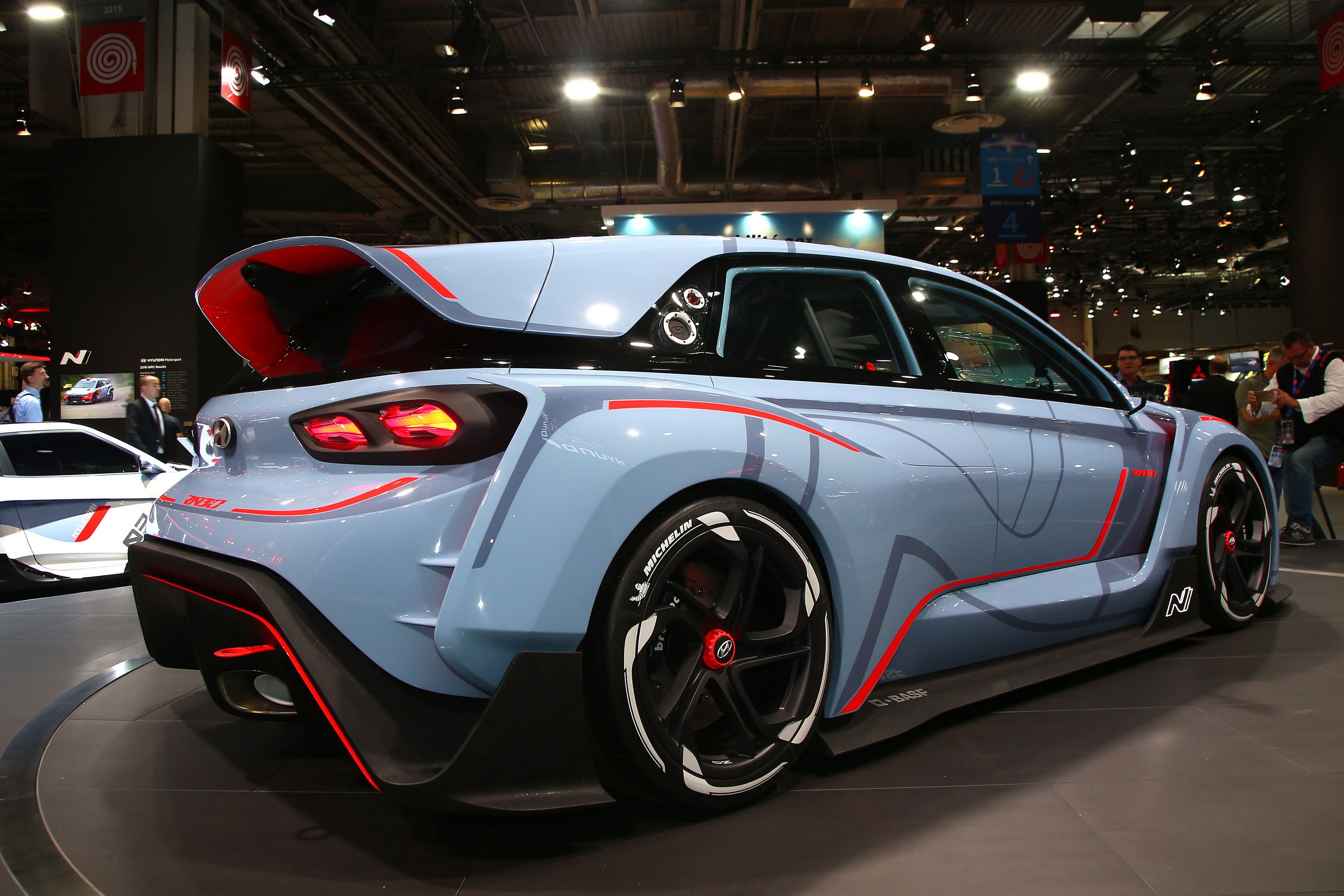In the grand scheme of things, it hasn’t been that long since Hyundai announced the long-awaited N performance division. The division is so new, in fact, that it has yet to sever the umbilical cord from its first official model, the Hyundai i30N – a model set to compete with models like the Ford Focus ST and the Volkswagen Golf GTI. Of course, we aren’t worthy of that model here in the U.S. for some reason, so we have to wait a while to lay eyes on our first Hyundai N car. Fortunately, that wait isn’t going to be that long as Hyundai has now confirmed that it will reveal a second N model in 2018, shortly after the debut of the i30N later this year.
The word came straight from Albert Biermann, Head of Testing and High Performance over at Hyundai N, at the reveal of the Hyundai Kona in South Korea. So far, there have been absolutely no details released about what the next N-car will be based on, but the RC30 concept did showcase a 375-horsepower engine with all-wheel drive – something that would have no issue putting the Focus RS to shame. Of course, that was based on the i30, so take that with a grain of salt. What’s equally as important is what was said by the head of Hyundai’s high-performance vehicle development center Joonhong Park, who says that there won’t be an “N model” for every Hyundai out there. Instead, the division will selectively choose what models will get the N treatment. So, what does that mean for the second N model? Keep reading to find out.
Keep it Simple, Stupid
With the current climate of the automotive industry, it’s easy to assume that Hyundai will consider bringing its hybrid and fuel-cell technology to its future N products, but as it turns out, that isn’t Biermann expects to happen right away, but left the possibility open for the future:
“ Hyundai has technology of every type – hybrid, plug-in hybrid, EV, fuel cell. Right now, there's no plan to bring that tech to N, but when the time comes, whether that's because the customer requests it or we think there's a moment or a need by regulation, we will be ready to have a sustainable, high-performance car.” He continued, “I could eventually see a more emotional EV performance car. But for me, it's hard to imagine a performance car without an engine – although maybe that's me getting old.”
So, the potential for a hybrid of fuel-cell N-car is certainly there, but I wouldn’t expect to see it anytime soon. That’s a good thing for those of us who prefer to keep the soul and emotion in performance cars, but it’s important to remember that a hybrid drivetrain could open up the door to more extreme performance should Hyundai want to prove its dominance with the heavy hitters.
The RN30 Concept
In 2016, Hyundai showed off the RN30 Concept. It was based on the i30 hatchback and showed potential to be a Focus RS killer, should it ever make it into production. Of course, we’ve seen the spy shots of the i30N, so we know that the second N-car won’t share that DNA, but it could share a lot of the same features, including the all-wheel-drive layout and that 2.0-liter four-cylinder that was tuned by none other than Hyundai Motorsport. It was said to be good for 375 horsepower and 333 pound-feet of torque, while the car itself featured lots of weight-saving components that were made in collaboration with BASF. The car had an extreme body kit, butterfly doors, performance suspension, electronically variable exhaust, and an electronic limited-slip differential.
So, while the second N-Car won’t look anywhere near the same as it won’t be based on the i30, it could very well make use of all the technology showcased in the RN30. But, what model would be able to take this kind of power and technology?
Round and Round We Go
Hyundai Veloster Turbo
So, Hyundai has come a long way in the past 20 years, but it doesn’t exactly have a lineup full of sporty coupes that can be injected with some of that sexy N DNA. But that doesn’t mean that the N division doesn’t have a few options to choose from. One of the most likely candidates is the Hyundai Veloster. Out of the three hatchbacks in Hyundai’s current lineup, it sits right in the middle between the Accent and the Elantra GT. And, until the 2018 Elantra GT hits dealers, it’s also the most powerful of the three with the 1.6-liter, turbocharged models (the Veloster Turbo and Turbo R-Spec) producing 201 horsepower and 195 pound-feet of torque.
What really makes it a competitor, however, is the fact that it’s already quite sporty for a compact hatchback. It has that big, sporty grille up front, an angular design all of the way around and the wide wheel arches gives it just the right amount of character and aggressiveness. Add on some of the aerodynamic goodies from the RN30 to go with the 375-horsepower four-banger and all-wheel drive, and you have a Hyundai that will put the Focus RS to shame. But, it’ll take some work to make it live up to that unreasonably high standard. In its most powerful form, the Veloster can go the 60-mph sprint in about 7.5 seconds and is estimated to top out around 155 mph. AWD, 375 ponies, and a bunch of weight saving materials could potentially drop that sprint time to as little as 4.5 seconds, which would beat out the Focus RS by 0.2 seconds. Is it too much to ask for a drift mode too?
Elantra GT
While the Veloster has some serious potential if Hyundai’s N division goes all out, the more likely candidate, in my opinion, is the new, 2018 Elantra GT. Introduced to the wild at the 2017 Chicago Auto Show, the new Elantra GT is sporty, charismatic, and offers up four doors and lots of extra space over the Veloster. And, unlike the Veloster, the new Elantra GT is already setup to take larger four-cylinders, as the base model comes with a 2.0-liter. Of course, it’s only good for 162 horsepower and 150 pound-feet of torque, while the GT Sport’s 1.6-liter delivers 201 ponies and 195 pound-feet. But, the point is, that 2.0-liter from the RN30 Concept would probably drop right in. And, if Hyundai played its cards right, it shouldn’t be that hard to integrate that AWD system into the driveline either. So, it’s got the looks and the frame for that powerful 2.0-liter, and integrated all of the weight saving technology shouldn’t be that difficult either. What’s equally important about the new GT, is that it has been strengthened over the outgoing model as well, which means it should be better equipped to handle more than 300 ponies. With a weight that barely surpasses 3,100 pounds, a 375-horsepower GT could pose a serious threat and may even return a 60-mph sprint time in the very-low four-second range – maybe even 4.1 seconds if done right.
Conclusion
So those are our two picks for the next N-car, and I tend to lean heavily toward the new Elantra GT as the primary candidate, especially when you consider Hyundai really wants to compete with the Focus RS. And, while that seems like the most likely scenario, we need to remember that Hyundai also has the Genesis luxury brand, and there’s no reason why a car like the Genesis G80 sport couldn’t get the N treatment as well. Of course, you’ll be stuck with an automatic transmission, but if Hyundai pushed that up to somewhere around 500 ponies, and made use of its weight saving technology, the G80 Sport would be able to compete with models like the Mercedes-AMG E43 or even the M6. Of course, that’s a long shot, but it is possible in the future – especially if Hyundai decides to introduce the N Division to its hybrid technology as well.
Needless to say, Hyundai has come a long way, and it’s setting itself up to go even further with the new N performance division. What car would you like to see get the N treatment next? Will the Veloster be the big candidate or will Hyundai go with the new Elantra GT? Or, do you think they’ll pick something else to wear an N badge? Let us know in the comments section below.


